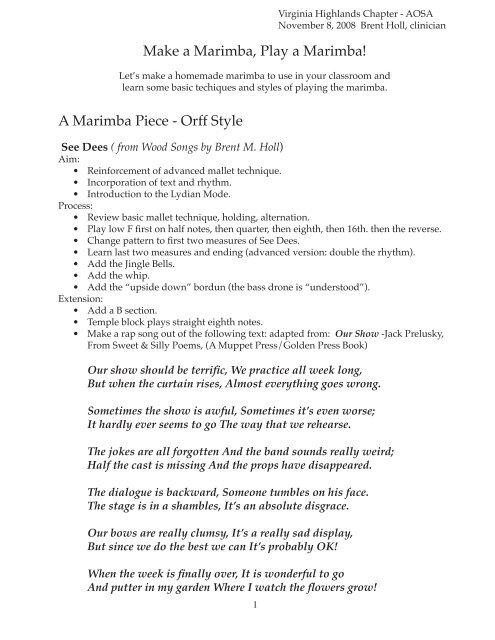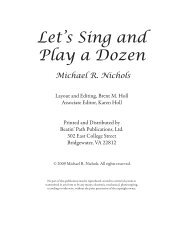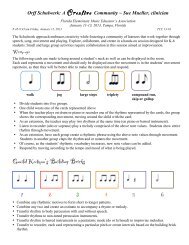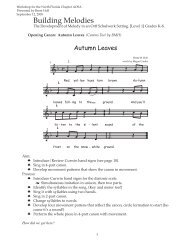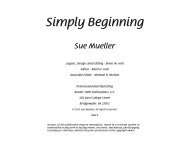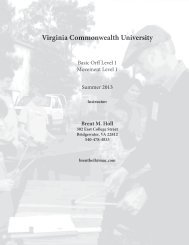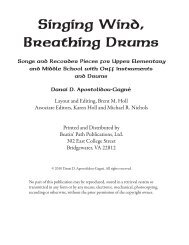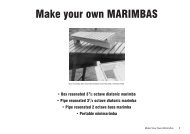Make a Marimba, Play a Marimba! - Beatin' Path Publications, LLC
Make a Marimba, Play a Marimba! - Beatin' Path Publications, LLC
Make a Marimba, Play a Marimba! - Beatin' Path Publications, LLC
Create successful ePaper yourself
Turn your PDF publications into a flip-book with our unique Google optimized e-Paper software.
Virginia Highlands Chapter - AOSA<br />
November 8, 2008 Brent Holl, clinician<br />
<strong>Make</strong> a <strong>Marimba</strong>, <strong>Play</strong> a <strong>Marimba</strong>!<br />
Let’s make a homemade marimba to use in your classroom and<br />
learn some basic techiques and styles of playing the marimba.<br />
A <strong>Marimba</strong> Piece - Orff Style<br />
See Dees ( from Wood Songs by Brent M. Holl)<br />
Aim:<br />
• Reinforcement of advanced mallet technique.<br />
• Incorporation of text and rhythm.<br />
• Introduction to the Lydian Mode.<br />
Process:<br />
• Review basic mallet technique, holding, alternation.<br />
• <strong>Play</strong> low F first on half notes, then quarter, then eighth, then 16th. then the reverse.<br />
• Change pattern to first two measures of See Dees.<br />
• Learn last two measures and ending (advanced version: double the rhythm).<br />
• Add the Jingle Bells.<br />
• Add the whip.<br />
• Add the “upside down” bordun (the bass drone is “understood”).<br />
Extension:<br />
• Add a B section.<br />
• Temple block plays straight eighth notes.<br />
• <strong>Make</strong> a rap song out of the following text: adapted from: Our Show -Jack Prelusky,<br />
From Sweet & Silly Poems, (A Muppet Press/Golden Press Book)<br />
Our show should be terrific, We practice all week long,<br />
But when the curtain rises, Almost everything goes wrong.<br />
Sometimes the show is awful, Sometimes it’s even worse;<br />
It hardly ever seems to go The way that we rehearse.<br />
The jokes are all forgotten And the band sounds really weird;<br />
Half the cast is missing And the props have disappeared.<br />
The dialogue is backward, Someone tumbles on his face.<br />
The stage is in a shambles, It’s an absolute disgrace.<br />
Our bows are really clumsy, It’s a really sad display,<br />
But since we do the best we can It’s probably OK!<br />
When the week is finally over, It is wonderful to go<br />
And putter in my garden Where I watch the flowers grow!<br />
1
Virginia Highlands Chapter AOSA<br />
November 8, 2008 - Brent Holl, clinician<br />
See Dees<br />
Soprano<br />
Xylophone<br />
Alto<br />
Xylophone<br />
Jingle<br />
Bells<br />
Whip<br />
Bass<br />
Xylophone<br />
&<br />
&<br />
÷<br />
÷<br />
&<br />
c<br />
c<br />
c<br />
c<br />
c<br />
Brent M. Holl<br />
œ<br />
œ œ œ œ œ œ œ œ œ<br />
œ<br />
œ œ œ œ œ œ œ œ œ<br />
œ œ œ œ œ<br />
œ œ œ œ œ œ œ œ<br />
œ œ œ<br />
œ œ œ œ œ œ œ œ œ œ œ œ œ œ œ œ<br />
œ œ œ œ œ œ œ œ œ œ œ œ œ œ œ œ<br />
∑<br />
∑<br />
SX<br />
AX<br />
Jng.Bls.<br />
Whip<br />
BX<br />
3<br />
&<br />
&<br />
÷<br />
÷<br />
&<br />
1 2<br />
œ<br />
œ œ œ œ œ œ œ œ œ œ œ œ œ . œ œ œ œ œ œ œ Œ<br />
U<br />
œ œ œ œ œ œ œ œ œ œ œ œ œ œ œ œ . œ œ œ œ œ œ œ œ<br />
œ œ œ œ œ œ œ œ œ œ œ œ œ œ œ œ . œ œ œ œ œ œ œ œ<br />
∑<br />
∑ . Œ Œ Œ œ<br />
.<br />
œ œ œ œ œ œ œ œ œ œ œ œ œ œ œ œ œ œ œ œ œ œ œ œ<br />
.<br />
.<br />
.<br />
.<br />
.<br />
2
A <strong>Marimba</strong> Piece - African Style<br />
Abudah ( from Wood Songs by Brent M. Holl)<br />
What’s New:<br />
• Learn a basic syncopated pattern as a generator for melody<br />
• Reinforce mallet technique advancing to 16th note rhythms<br />
• Learn to shift from an A section to a B section<br />
• Learn about double stops<br />
• Learn a basic Shakere pattern as accompaniment<br />
Process:<br />
• Learn the SX A section first.<br />
ɶɶ Use imitation first, then show the notation for the syncopated pattern.<br />
ɶɶ Break down the arpeggio pattern in the last two measures and learn using a vi-<br />
sual.<br />
• Learn the SX B section.<br />
ɶɶ Emphasis is on precision with 16th notes.<br />
ɶɶ Learn to shift from the A section to the B section.<br />
ɶɶ <strong>Make</strong> sure the form is learned well. (How many times is the 2 measure motif<br />
repeated in the B section)<br />
• Learn the CBX part.<br />
ɶɶ Emphasize the basic syncopated pattern that everyone learned in the SX part.<br />
ɶɶ Learn the B section, noting that the rhythm has shifted to straight 8’s.<br />
ɶɶ Combine with Soprano part and work till secure.<br />
• Learn the BX part.<br />
ɶɶ Click sticks together on the rests.<br />
ɶɶ Add the two syncopated measures, noting the use of double stops, and the<br />
straight 8 ending.<br />
• Learn the two alto parts.<br />
ɶɶ Note the similarity in rhythm to the soprano part.<br />
ɶɶ Spend some time breaking down the double stop rhythm.<br />
• Learn a basic Shakere accompaniment pattern.<br />
3
Virginia Highlands Chapter AOSA<br />
November 8, 2008 - Brent Holl, clinician<br />
4
Virginia Highlands Chapter AOSA<br />
November 8, 2008 - Brent Holl, clinician<br />
A <strong>Marimba</strong> Piece - Aussie Style<br />
Grace and Favor by Jon Madin (from his book, <strong>Marimba</strong> Music 1)<br />
What’s New:<br />
• Incorporating other instruments into the marimba ensemble<br />
• Learning chords and chord changes<br />
• Making melodies from simple 5 note patterns<br />
Process:<br />
• Establish the key of C.<br />
• Ask for 5 note melodies going up and down.<br />
• Keep working till you find: CDEFG; FEDCB; and ABCDE.<br />
• Put on a cadence, add a repeat and final cadence and play the whole thing.<br />
• Add a bass part, working from the descending 5 note scale: CBAGF.<br />
• Add the cadence: GCG.<br />
• Add chords with marimbas, guitars, recorders, or any other available instruments.<br />
• Add the B section. Note the contrast to the 5 note scale patterns and the single note<br />
repeated 5 times.<br />
<strong>Marimba</strong> Making at Crystal Spring Elementary Fall - 2008<br />
<strong>Marimba</strong> Making at Crystal Spring Elementary Fall - 2008<br />
The Project:<br />
The assigned task was to make one 3 1/2 octave marimba and one bass marimba at Crystal<br />
Spring Elementary School with the help music teacher, Gretchen Jensen, and the students<br />
from Grades K - 5. The school PTA provided the funding for the project. These marimbas<br />
were designed by Jon Madin, author of the books: <strong>Marimba</strong> Music 1 and 2 .<br />
The older students worked on tuning the tone bars using a mallet and wood chisel, while<br />
the younger students did the sanding and smoothing. We worked on the marimbas a total<br />
of four days with each marimba taking two days to complete. The frame and resonator<br />
pipe modules were made with parent help in a local wood shop. They were assembled and<br />
mounted at the school. Ms Jensen decorated the frames and pipe modules with assistence<br />
from the school’s art teacher. The goal of the marimba making activity was to let the students<br />
help make the marimbas, to observe the assembly process and finally learn to play<br />
them!<br />
The Process:<br />
An essential part of the project was to find a parent woodworker able to do the complicated<br />
task of measuring and cutting each tone bar to the required length, thickness and width.<br />
Our carpenter/parent also adapted and built the frame. Mr. Holl and Ms Jensen built,<br />
tuned, and mounted the tube resonator modules.<br />
6
The students were able to tune the bars with hammer and chisel and get them reasonably<br />
close to the correct tuning. Some fine tuning by Mr. Holl and Ms. Jensen finished each tone<br />
bar. We used an electronic tuner.<br />
The students took to their task with great enthusiasm. Mr. Holl had them go off in groups<br />
of two with each pair working on one bar. As they worked they would go to the electronic<br />
tuner and check the tuning of the bar. Mr. Holl helped them determine how far up or down<br />
in pitch they had to go and where to cut next. As each bar was finished it was mounted on<br />
the marimba frame. It was great fun to watch the marimbas slowly grow into complete instruments.<br />
Of course, the students played the new bars to see what they would sound like,<br />
which only added to their desire to finish the instruments and “get to the music.”<br />
Younger students were not asked to use the hammers and chisels but were able to sand and<br />
smooth the bars. Third graders were allowed to try the mallet and chisel with the help of<br />
Mr. Holl. Each student practiced making small “chips.” The Fourth and Fifth grade students<br />
were able to work with the mallet and chisel independently.<br />
The two marimbas were built with materials available at local hardware and auto parts<br />
stores. We used paduak wood for the marimba bars and white pine for the frames. The bass<br />
resonator tubes were made from thin walled 3” and 4” S&D PVC Drain pipe and the marimba<br />
tubes from 2 1/2” and 2” PVC pipe.<br />
Credits:<br />
<strong>Marimba</strong> Music 1 - Simple arrangements for diatonic marimbas, xylophones and other instruments<br />
by Jon Madin. © Jon Madin, 1994.<br />
Wood Songs - Ensemble pieces for xylophones and marimbas grades 4 - 8 by Brent Holl.<br />
© 2003 Brent M. Holl. All rights reserved. Beatin’ <strong>Path</strong> <strong>Publications</strong>, Ltd. 302 East College<br />
Street, Bridgewater VA. 22812.<br />
Other <strong>Marimba</strong> resources:<br />
Ensemble - Easy and intermediate pieces for Orff Ensemble Grades 4 - 8 by Brent Holl. ©<br />
2002 Brent M. Holl. All rights reserved. Beatin’ <strong>Path</strong> <strong>Publications</strong>, Ltd. 302 East College<br />
Street, Bridgewater VA. 22812.<br />
Hot <strong>Marimba</strong> and <strong>Marimba</strong> Mojo - Zimbabwean-style music for Orff instruments by Walt<br />
Hampton. © 1998 Walt Hampton/World Music Press. World Music Press, PO Box 2565<br />
Danbury CT 06813.<br />
Behind Bars - Percussion ensembles for young musicians by Mari Schay. © 2006 Woodsprites<br />
Publishing, Portland Oregon. woodsprites@qwest.net<br />
Wooden Voices - Twelve original works for marimba ensemble, beginning to advanced by<br />
Eric Schopmeyer, Adrienne Leverette, Rebekah Phillips, and Lars Campbell. © 2006 Woodsprites<br />
Publishing, Portland Oregon. woodsprites@qwest.net<br />
7
Virginia Highlands Chapter AOSA<br />
November 8, 2008 - Brent Holl, clinician<br />
Note to workshop participants:<br />
Please feel free to use anything in these notes written or arranged by<br />
Brent Holl for your own professional use in class or workshops. Simply make<br />
sure that the following notice is on each copy.<br />
© Brent M. Holl, 2008. All rights reserved. Used by permission.<br />
For all other materials permission must be obtained from the copyright holder.<br />
This workshop has been presented by:<br />
Brent M. Holl<br />
302 East College Street<br />
Bridgewater, Va. 22812<br />
540-478-4833<br />
brentholl@mac.com<br />
www.brentholl.com<br />
8


